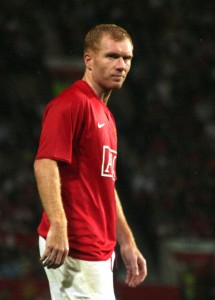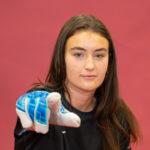O’Sullivan: The missing ingredient in North American soccer talent development
In 2005, the coaches at one of the English Premier League’s top youth academies held one of their semiannual meetings to decide upon which players they would keep for the upcoming cycle, and whom they would let go. As they were evaluating their players –many of whom would go on to star not only in the EPL, but internationally as well – they were stuck on one particular 15-year-old boy.
He had been a good player when he first entered their academy, but recently he had grown a bit and was no longer scoring well in their physical testing, nor playing like he had a few years earlier. In fact, the once-speedy player was now only the seventh-fastest kid on the team!
+ READ: O’Sullivan: How to raise a lion chaser
These incredibly qualified and highly respected coaches were torn; some wanted to keep him and offer him a scholarship to continue his training; others thought they should let him go. It was touch and go.
To break the tie, the coaches brought in their chief scout, a man named Rod Ruddick, to help them decide. Ruddick was the scout who had found the boy play at age 9 and had first invited him to join. He also had a hunch that the player was going through a difficult time as he grew, and that soon the kid he remembered would reemerge. He cast his tie-breaking vote to keep the player (read more about Ruddick here).
Within two years the player would make his first team senior debut for the club, and become the youngest international player in his country’s history. In 2007 he was transferred to Tottenham Hotspur for a fee that eventually became about $10 million, and in 2013, that speedy winger proved that the staff at Southampton were right to keep him, as he became the most expensive signing in world soccer history when he was bought by Real Madrid for more than $131 million.
His name was Gareth Bale.
The story of Gareth Bale, and other late developing athletes such as Danish international soccer player Simon Kjaer (whom I have written about here), Michael Jordan, or NFL quarterback Steve Young, are worth retelling because they beg the question, “Would these kids have made it today in the United States?”
Would we keep a player who seemed to be declining in ability? Would we keep a player that did not help us win today? Can we identify not just the talent that shines bright, but the talent that whispers?
Currently, in many places the answer is no, we would not keep a player who is not helping right now, because American youth sports is missing the most important prerequisite of talent development.
PATIENCE!
With our endless obsession for winning and younger and younger ages, and the accompanying cuts that go into forming select and all star teams at ages as young as 7, we have created a system that goes against all the science and best practices of player development. That science says that children develop at different rates, and the best way to let the cream rise to the top is keep as many of them around as long as possible. Yet we do the exact opposite in our quest to win today. We select talent instead of identifying it (click here to read more on that).
We focus on today instead of tomorrow.
We pick the biggest, fastest and strongest kids, focusing on athleticism instead of technique, grit and coachability.
We get rid of kids who don’t help us win in the short term.
We celebrate team achievements at pre-pubescent ages, as if that has anything to do with long-term athletic development.
We hold kids back from playing up with a developmentally appropriate age group, instead keeping them so they can dominate – and we can win – at a younger age.
+ READ: O’Sullivan: The race to nowhere in youth sports
In a nutshell, we put the needs of team success over the needs of individual player development, and put winning now ahead of individual long-term player needs.
We have lost our patience to develop players because we can get away with it. In the US, we are blessed with such huge numbers of athletes across a variety of sports. We can do a lot wrong and still compete on the international stage. Yet the world is catching up in sports we have traditionally dominated (baseball, track and field, basketball).
In sports that we are newcomers to, such as soccer, countries such as Uruguay and Portugal, with only a small percentage of our population, are producing higher-quality players and equal or better teams. Why? A variety of reasons to be sure, not the least of which is because they have the patience to develop talent.
Our biggest obstacle to patient talent development is our obsession with winning. I have met many coaches and clubs that tout their focus on player development who then proudly posts a picture of their 8 year old state championship team on their website.
To produce these “winning” teams, we cut kids from our programs in elementary school, essentially telling them they are not good enough. We form “A” and “B” teams at 7 or 8 years old, and lock in kids to teams for an entire year, even though players this age can change so much in a month or two.
And who gets cut from these pre-pubescent teams? Usually the kids who were born more than six months after the arbitrary calendar cutoff are the ones who are let go. They are at a disadvantage through puberty because they are a little bit smaller, a little bit weaker and slightly less mature. A few months can make a significant difference prior to their growth spurt (for example, a 13-year-old boy has a six-year developmental age swing, meaning he could have the body of a 10-year-old or a 16-year-old!).
 If you want to make it as a youth player, you have a far greater likelihood of being selected to a top team if you are “old” for your age. (To be fair, this is not just an American problem. In England, most youth soccer academy players are born in September through December (age cutoff is September 1) while in Spain (January 1 cutoff), most are born January through April.)
If you want to make it as a youth player, you have a far greater likelihood of being selected to a top team if you are “old” for your age. (To be fair, this is not just an American problem. In England, most youth soccer academy players are born in September through December (age cutoff is September 1) while in Spain (January 1 cutoff), most are born January through April.)
Talent identification is certainly not easy. Take for example retired Manchester United great Paul Scholes, of whom his future manager Alex Ferguson said, after watching him in a youth game, “He has got no chance – he’s a midget.”
At age 16, Scholes struggled with asthma and injuries. He was technical and creative, but athletically he was behind the others. As his academy director Lev Kershaw stated:
“He was a little one. He had asthma. No strength. No power. No athleticism. No endurance. ‘You’ve got a bleeding dwarf,’ I remember somebody said to [former youth team coach] Brian Kidd. ‘You will eat your words,’ said Kidd. If Scholes had been at a lesser club, they would have got rid of him and he would probably not be in the game now. We stuck with Scholes, a wonderful technician.”
Over the next 20 years, Scholes played over 700 games, scored over 150 goals, and won over 20 league championships, cups and two UEFA Champions League titles. He became arguably the best player of his generation, earning plaudits upon his retirement from every top player in the world. All of this only happened because Manchester United’s youth setup had patience.
American coaches need to practice this same patience. Let all your players play; it you pick them, then play them! Understand that development is not a straight line, and that kids will have good periods and bad ones. Know that not every child learns just because you taught them something; teaching and learning are not the same thing. Stop being in such a hurry to pick “elite” teams and take the time to develop more players instead of a select few. The list goes on and on.
Now I am certainly not casting all the blame on coaches who are in too big a hurry.
Parents, you need patience as well. The sky is not falling when your son or daughter does not make the top team at 9 years old. In fact, most sports organizations I know have a 75 percent turnover rate on their top team from age 11 to 18. The vast majority of the players in the “A” group at age 10 will not be there in five or six years, so relax.
Actually, be glad. Your child is far better off being one of the top players on a “B” team then sitting the bench on the top team. He needs to play. Winning championships does not matter much to a kid who played no part. If a young player is not injured, and making a full commitment to attend training, he should be playing! If he is not playing at least half a game, you really should consider another team, because the one you are on is not concerned with everyone’s development.
Parents also need to be patient with coaches. Coaches have a tough job. Your child does not get 100 percent of their attention, they get 1/16 of it, or one divided by whatever number of kids is on the team. They will not see every little thing you do.
+ READ: Best advice for soccer parents: Keep quiet on the ride home
Great coaches will also push your child out of the comfort zone, and perhaps even make her unhappy once in a while. That is their job, because it promotes learning. Your child needs to play different positions, she needs to have different roles, she needs to both start and come off the bench. A youth team that has the same coach for 10 years is not a team that is developing players; it is embedding them in roles and a level of comfort that hinders development. Learning does not happen overnight, and takes a variety of forms, so embrace change, be patient and let it happen.
 Parents, one day you will look back on your child’s youth sports experience, and the things you will be thankful for are unlikely to be the U11 Joe Smith Super Duper Elite Cup championship. They will be the lessons your child learned from both good times and times of adversity.
Parents, one day you will look back on your child’s youth sports experience, and the things you will be thankful for are unlikely to be the U11 Joe Smith Super Duper Elite Cup championship. They will be the lessons your child learned from both good times and times of adversity.
You will be thankful for the lessons your kids learned from being surrounded by positive adult role models, not the ones who only focused on the now.
You will look fondly upon the times your child struggled and overcame obstacles, the friends she made, and the positive memories that sport can bring.
You will be thankful that you had the patience to take the good and the bad, and to let your child develop as children do; not in a straight line, but in a squiggly, messy, line, improving, struggling, failing, moving on, and all the while on a journey with an unknown destination, but a well-charted path of both success and failure.
If we truly want to be a country that develops talent, instead of churning through it and getting lucky that we have enough players to still compete at the end, then its time to start developing talent the right way.
It is time to practice patience.
Because the next Gareth Bale or Paul Scholes might be on your team, huffing and puffing, stumbling and failing, and not yet showing signs of future greatness, yet bursting with talent just waiting to blossom. All they need is time!
All they need is patience!
Please leave your comments and thoughts below on how we can be more patient in American youth sports.
—
SOCCERWIRE MARKETPLACE
- Girls College ID Soccer Camp – Showcase Your Skills!
- Real Colorado Cup 2026
- Join a College Coaches Showcase Camp Today
- MICFootball Punta Cana 2026
- Dana Cup Hjørring 2026
- 15th Annual Loudoun Soccer College Showcase
- OFFICIAL FC BARCELONA SOCCER CAMPS - PROMO CODE: FCBSOCCERWIRE
- New England Copa Surf 2026
- Adidas National Cup 2026
- visitRaleigh.com Showcase Series 2025, hosted by NCFC Youth












